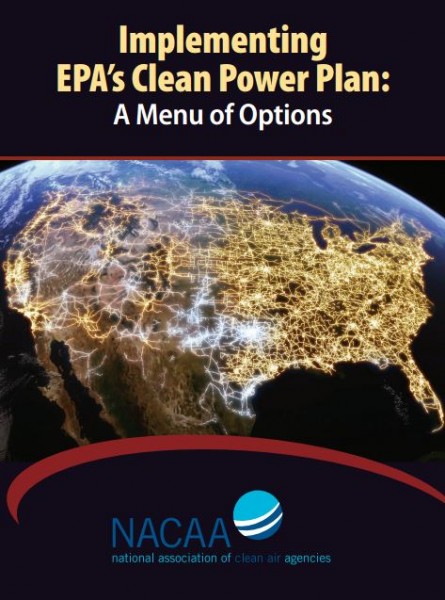
Yesterday, the National Association of Clean Air Agencies (NACAA) released an important new resource: Implementing EPA’s Clean Power Plan: A Menu of Options (disclosure: RAP provided technical assistance and helped write the Menu). We believe the Menu is one of the most important documents available to the thousands of state air quality agency staff and state energy regulators all over the country who will ultimately be tasked with crafting their states’ Clean Power Plan compliance plans.
The 26-chapter, 465-page encyclopedic Menu covers a wide array of technological and policy options available for reducing greenhouse gas emissions from the power sector. With the flexibility states have under the U.S. Environmental Protection Agency’s (EPA) proposed Clean Power Plan, and the plethora of options to comply, every state will find options that enable affordable, reliable power, advance other state public policy goals, and deliver greenhouse gas reductions. Many of the options are simply sound energy policy and worth consideration even in the absence of a greenhouse gas mandate.
The Menu highlights what is possible, both within EPA’s four building blocks and well beyond them. We encourage states to evaluate all clean energy policies, and to consider whether they can be expanded or improved for their purposes. Not every option will be a good fit for every state, but we expect every state to find something in the Menu that will complement its unique political and regulatory landscape. States may also find that the Menu provides a useful starting point for discussion and collaboration with their utilities, local technical experts, and stakeholders.
Regardless of what a state may think of the legality of the Clean Power Plan, using the Menu to begin or further conversations about what a compliance plan might look like will help preserve flexibility and enhance the ability to tailor a plan to meet its particular circumstances at lower cost and with greater certainty. With publication of the final Clean Power Plan—anticipated later this summer—experts expect EPA to propose a federal implementation plan. States that choose a “just-say-no” approach or fail to propose a workable plan, could forfeit their flexibility and the ability to advance other state policy goals. Instead, they may be subject to a one-size-fits-all federal implementation plan.
As with any technical document of this magnitude, the Menu is bound to be outdated the day it is published. In fact, we expect continuing technological advances to render several of the Menu’s options even more compelling today and tomorrow than the characterizations embodied in it. Because the Menu is based on the proposed Clean Power Plan, some options may need to be adapted once the final rule is issued. Overall, however, the Menu provides states with a comprehensive and credible starting point for the many conversations and planning processes that must happen on the road to affordable, reliable compliance.
Both NACAA and RAP are available to provide technical assistance to states as they embark on their Clean Power Plan compliance efforts. Those interested in making the most of their efficiency programs will find RAP’s Driving Energy Efficiency: Applying a Mobile Source Analogy to Quantify Avoided Emissions a good place to start. Others interested in maximizing the contribution of renewable energy will enjoy RAP’s recent collaborations with the Center for Resource Solutions, Tracking Renewable Energy for Compliance with the Clean Power Plan. Many other helpful resources are also available in our resource library.
